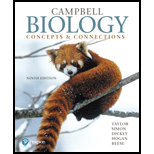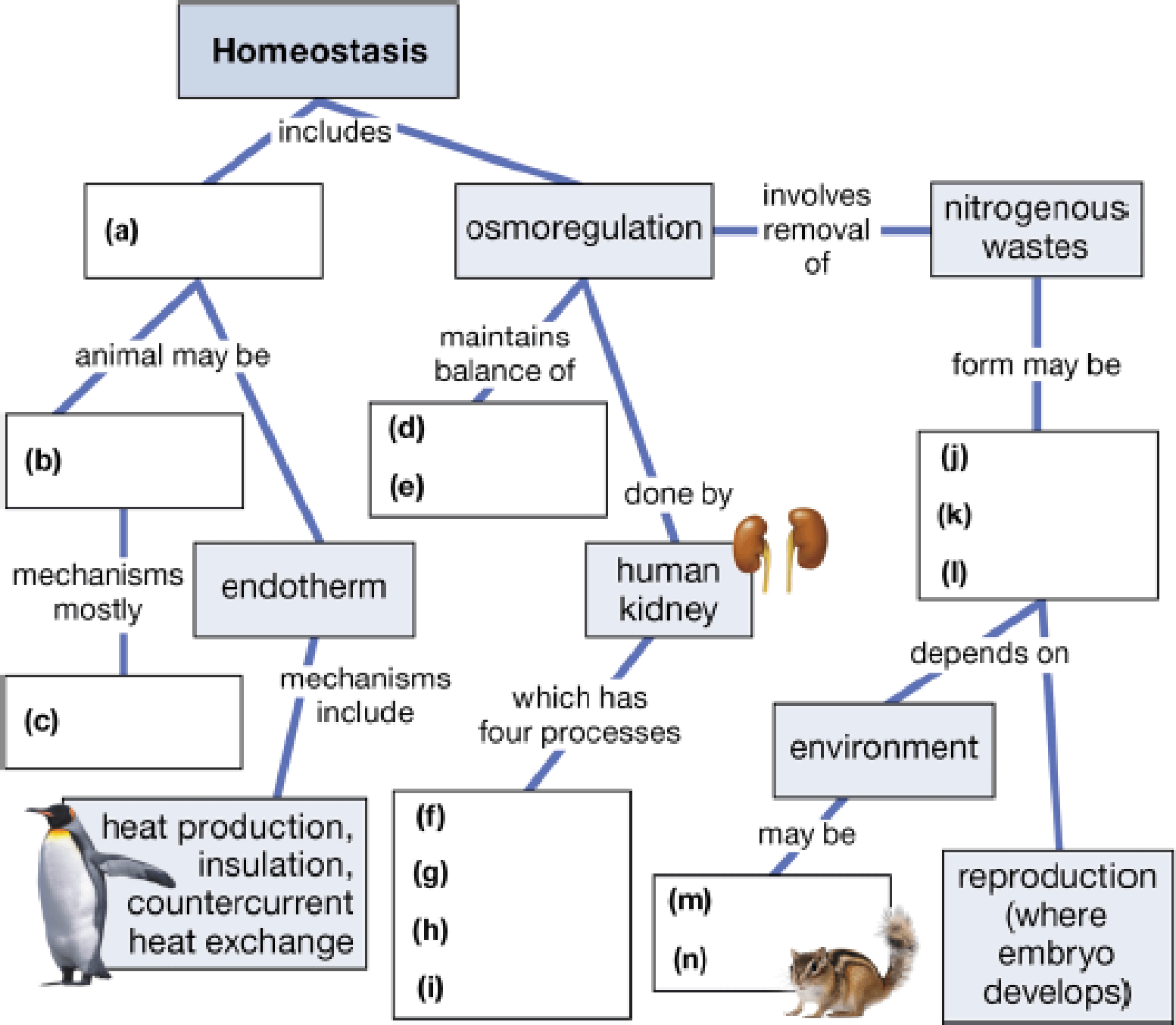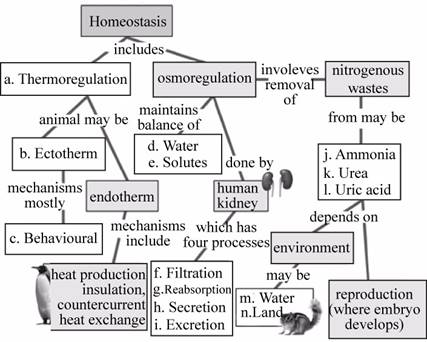
Concept explainers
Complete this map, which presents the three main topics of this chapter.

To complete: The given map representing the three main topics of this chapter.
Concept introduction: The processes such as thermoregulation and Osmoregulation are very essential for maintaining the homeostasis of the body.
The change in constant internal body temperature can impair the activity of enzymes and therefore, can result in death. The disturbance in osmolarity can have similar effects.
Answer to Problem 1CC
Pictorial representation: Fig.1 shows the completed map representing the three main topics of this chapter.

Fig.1: Three main topics of the chapter.
Explanation of Solution
(a)
Correct answer: Thermoregulation
Explanation: Thermoregulation is a homeostatic mechanism in animals that maintains the constant internal body temperature regardless of external temperature fluctuations. Hence the correct answer is thermoregulation.
(b)
Correct answer: Ectotherm
Explanation: Ectotherms are those animals that can regulate their body temperatures by gaining heat from surroundings. Hence, the correct answer is ectotherm.
(c)
Correct answer: Behavioral
Explanation: Ectotherm maintains constant body temperatures by behavioral responses such as huddling, migration and sun bathing. Hence, the correct answer is behavioral response.
(d)
Correct answer: Water
Explanation: The Osmoregulation is a process by which an organism maintains balance of water in the body. Hence, the correct answer is water.
(e)
Correct answer: Solutes
Explanation: The Osmoregulation is a process by which an organism maintains balance of solutes in the body. Hence, the correct answer is solutes.
(f)
Correct answer: Filtration
Explanation: It is one of the four processes by which the kidneys produce urine. In this process, the hydrostatic pressure in the glomerular capillaries drives the filtration of blood. Hence, the correct answer is filtration.
(g)
Correct answer: Reabsorption
Explanation: It is one of the four processes by which the kidneys produce urine. In this process, the essential nutrients such as glucose, amino acids, salts and water are reabsorbed into the blood. Hence the correct answer is reabsorption.
(h)
Correct answer: Secretion
Explanation: It is one of the four processes by which the kidneys produce urine. In this process, the extra ions, drugs and other harmful substances are secreted into the renal tubules and are excreted out of the body. This process takes place in the distal convoluted tubules. Hence, the correct answer is secretion.
(i)
Correct answer: Excretion
Explanation: It is the last process in the urine production. In this process, the harmful waste substances are eliminated from the kidneys in the form of urine. Hence, the correct answer is excretion.
(j)
Correct answer: Ammonia
Explanation: Ammonia is one of the form in which nitrogenous waste can be eliminated. The excretion of nitrogenous waste in the form of ammonia generally occurs in aquatic organisms. Hence the correct answer is ammonia.
(k)
Correct answer: Urea
Explanation: Urea is one of the form in which nitrogenous waste can be eliminated. Many mammals including humans, amphibians and some bony fishes excrete urea. Hence the correct answer is urea.
(l)
Correct answer: Uric acid
Explanation: Uric acid is one of the form in which nitrogenous waste can be eliminated. Many birds, some reptile and some insect excrete uric acid. Hence the correct answer is uric acid.
(m)
Correct answer: Water
Explanation: The form in which the nitrogenous waste is to be excreted depends on the environment, which can be water. Hence the correct answer is water.
(n)
Correct answer: Land
Explanation: The form in which the nitrogenous waste is to be excreted depends on the environment, which can be land. Hence the correct answer is land.
Want to see more full solutions like this?
Chapter 25 Solutions
Campbell Biology: Concepts & Connections (9th Edition)
- 22. Which of the following mutant proteins is expected to have a dominant negative effect when over- expressed in normal cells? a. mutant PI3-kinase that lacks the SH2 domain but retains the kinase function b. mutant Grb2 protein that cannot bind to RTK c. mutant RTK that lacks the extracellular domain d. mutant PDK that has the PH domain but lost the kinase function e. all of the abovearrow_forwardWhat is the label ?arrow_forwardCan you described the image? Can you explain the question as well their answer and how to get to an answer to an problem like this?arrow_forward
- Describe the principle of homeostasis.arrow_forwardExplain how the hormones of the glands listed below travel around the body to target organs and tissues : Pituitary gland Hypothalamus Thyroid Parathyroid Adrenal Pineal Pancreas(islets of langerhans) Gonads (testes and ovaries) Placentaarrow_forwardWhat are the functions of the hormones produced in the glands listed below: Pituitary gland Hypothalamus Thyroid Parathyroid Adrenal Pineal Pancreas(islets of langerhans) Gonads (testes and ovaries) Placentaarrow_forward
- Health Safety And Nutrition F/Young ChildHealth & NutritionISBN:9781305144767Author:MAROTZPublisher:CengageCase Studies In Health Information ManagementBiologyISBN:9781337676908Author:SCHNERINGPublisher:Cengage
- Essentials Health Info Management Principles/Prac...Health & NutritionISBN:9780357191651Author:BowiePublisher:Cengage





